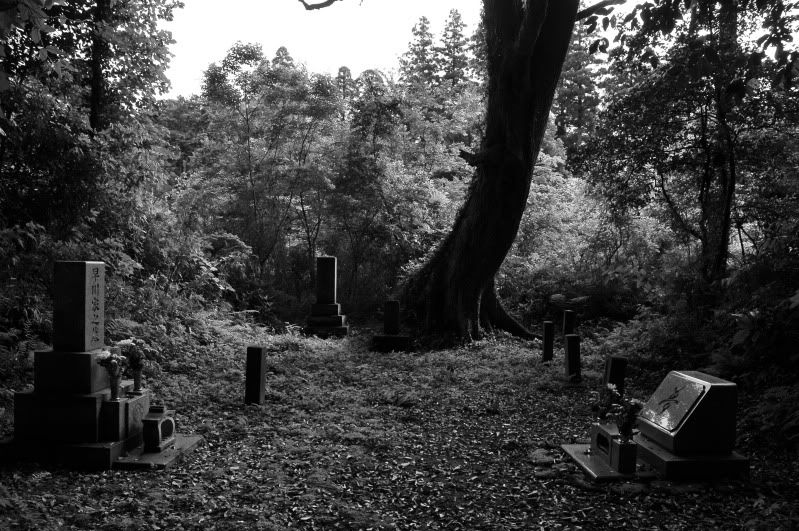I'm sure many of you have seen the pictures of Japan which I have posted in this section. They were all taken using either a Nikon D70s, or the Nikon D300 which I recently purchased. Both are digital cameras, and I've enjoyed using them to take pictures whenever and wherever I've had the opportunity.
Last month I came across a good deal on a large format film camera, and I decided that it was too good to pass up. As much as I enjoy the convenience of digital photography, to tell the truth, there is no digital camera currently made that can come close to producing the results that can be had with a large format film camera.
My large format kit is made up of the following: A Wista 45 view camera, 2 Rodenstock lenses (one wide angle, and another "normal"), a heavy Benbo tripod, and the usual assortment of film holders and small parts.
Yesterday morning I decided to pack up all this and go take some pictures. Since I was using black and white film in the camera, I wanted to photograph things that would look good in that format. In the hills above the city there is an old cemetery located in the middle of a thick forest; the perfect place. The light was just right, as the sky was cloudy, which eliminates shadows and gives a uniform image.
In case you aren't aware of it, a large format camera is rather heavy, especially when you throw in the accessories, film holders, tripod, and tripod head. I loaded all this stuff into a backpack, and set out. I walked past the train station, hiked around the lake by my school, passed the Honzanji temple, and climbed the 230 stairs which led to the path that passes through the cemetery. Needless to say, I was quite tired by the time I reached the top of the steps.
The cemetery was just as you would expect it to be; dark, shadowy, and somewhat spooky. The trees growing among the monuments were very large, with their leaves and branches obscuring the sky; I could hear creaking sounds from above as the wind caused limbs and branches to rub against each other. But it wasn't all that scary, there were flowers blooming everywhere, and the air was heavy with their scent. The trees were full of birds, and they were singing happily.
I brought my D300 with me, as I didn't yet have a light meter for the Wista camera. I set the D300 to black and white, and I moved the ISO setting to 100 to match the film I had loaded in the film holders. I then set the focal length to match as well. I walked around and composed a few images on the Nikon's LCD screen, trying to get some ideas on where to set up the Wista.
But, as luck would have it, the sun decided at that moment to burn through the clouds. My pleasant, soft, gray light quickly turned into harsh splashes of sunlight and dark shadow. Such conditions are terrible for photographs, the bright light gets washed out, and details in the shadows become invisible. I couldn't take any pictures there.
Just past the cemetery were a few acres of farmland which hobby farmers used to grow kitchen vegetables. I knew it was a pretty place, and the bright sun would actually be a benefit there.
I walked to up the road and set my camera up at the edge of the farmland, intending to get a shot of the road and old fence in the foreground, the crops in the middle, and the tall trees of the forest to the back.
Setting up a large format camera is an exercise in patience. First, I set up the tripod, then I mounted the camera to it. Then I unfolded the camera and slid out the bellows. After that I mounted the lens to the front movement. Once these steps were completed, I used a spirit level to make sure the camera was precisely level. After that, I opened the shutter on the lens, and opened the hood around the ground glass to the rear. I focused the camera roughly, making sure that the image was more or less the same as that which I had composed with my D300.
Once all of this is done, things begin to get a little complicated. A regular camera focuses along a single, flat plane. A large format camera can be focused on multiple planes and angles, allowing one to adjust the perspective and focus in a way which isn't possible with any other camera.
I used the in-and-out focus knob to focus about halfway up the trees which were on the far side of the farm. This left the foreground somewhat out of focus. To correct this, I tilted the lens downward slightly. I worked wit the focus and tilt until both parts of the image were perfectly in focus with the aperture wide open.
But wait, that's not all. Now that I had the image composed and focused, I had to set my exposure. I took my D300, pointed it at the same landscape that was composed on the Wista, and looked at the readings on the top. I found the readings not to be compatible, of course, so I set the Nikon to aperture priority and stopped down the camera until the shutter speed came into the same range as the speeds available on the Wista. The Nikon came up with a shutter speed of 40, and an aperture of f20. I used these settings on the Wista.
After all this work, I was almost ready to take a picture. I took a film holder from my backpack, and slid it into the back of the camera. I then closed the shutter on the lens. I pulled the slide out of the film holder and reached around for the shutter release cable.
But at that moment I heard a car coming up from behind me. I turned and looked at the car, which was an ancient Nissan Skyline wagon. I knew the car, as it belonged to one of the farmers. I reluctantly picked up my camera and tripod and moved them so his car could get by. He waved to me and bowed behind his steering wheel as he slowly drove past.
As luck would have it, he parked his clunker Nissan right in the middle of the landscape that I had just set up to photograph. Oblivious to ruining my picture, the farmer walked up to me smiling and wishing me a good morning. He then looked carefully at my camera, saying "professinoaru camera desu ne?". He then looked at the label on the back ("Wista, Made in Japan"), and exclaimed "aah, sugoi! ii camera desu ne?". I pointed to my D300 sitting on my backpack "Nikon ichiban suki desu" I said; he walked over and picked it up carefully, saying "takai...". He set it down much more carefully than he had picked it up, wished me a good day, and went over to his tomato plants.
Since I hadn't come to a scenic hilltop farm to photograph an old Nissan wagon, I had to move my camera to another spot and recompose. I found another picture-worthy view, and recomposed, repeating the same routine I described above.
As I was setting up, another farmer showed up, this time on foot. He wished me a good morning as well, then went over to the first farmer and began to talk to him. Of course I was the main topic of conversation, as I heard "America-jin" said many times. But then their talk went back to the things farmers talk about; weather, big tomatoes vs small, and the size of this year's carrots.
I focused, tilted, and swung, then I made another exposure reading, matched the camera to it, closed the shutter, put in the film holder, pulled out the slide, snapped the picture, inserted the slide, flipped the film holder, removed the slide, snapped another picture, and reinserted the slide. I repeated this process in three different places, ending up with a grand total of six images.
Returning home, I set up my "darkroom". I put a couple of inches of water into my bathtub, and set 4 trays inside. I put developer in the first tray, water in the second, fixer in the third, and water with dish soap in the fourth. I made sure that the temperature of the water and the chemicals were all 20 Celsius. I set a digital timer for 12 minutes 30 seconds, and I sat my 3 film holders on the floor next to the tub. I turned out the lights.
In utter darkness I unloaded the film holders and stacked the film sheets on a clean towel. I pushed the button on the timer, and put the sheets of film into the first tray. I then shuffled the film sheets in the tray, taking the bottom sheet and putting it on the top, and repeating over and over again until the timer began to beep. I then moved the film sheets to the second tray, and rinsed them for a minute or so to stop the development process. Then I moved them into the fixer tray, and shuffled them in there for another 2 minutes. I turned on the lights, and was happy to see that my 6 sheets of film had become 6 very clear looking negatives. I moved them into the tray of soapy water, and shuffled them yet some more to get them clean. I then hung them up on a the clothes drying rack which I had suspended from the shower head.
Sound like a lot of work? You bet. Is it worth it? I think so. It is time consuming, but not difficult or expensive. I got the camera and lenses for $30 (a lucky find, about 1% of their real value); the film, chemicals, thermometer, developing trays and egg timer cost less than $40.
I'm awaiting the arrive of a new digital film scanner, when it arrives I'll be able to post the pictures I took.






